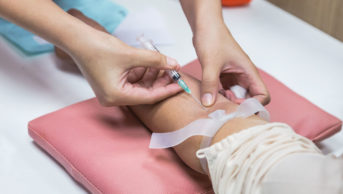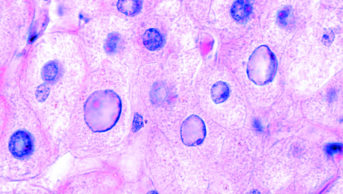This content was published in 2011. We do not recommend that you take any clinical decisions based on this information without first ensuring you have checked the latest guidance.
Complications that occur in patients with liver disease are seen most often in those with chronic liver damage. However, some complications, such as hepatic encephalopathy and clotting disorders, can also occur in acute liver failure. The management of the following complications remains the same regardless of the cause of liver disease.
Deranged clotting
Because the liver is the principal site for the synthesis of coagulation factors, clotting abnormalities are likely to develop in patients with liver disease. Patients who develop deranged clotting should receive intravenous doses of vitamin K (phytomenadione 10mg for adults). An oral, water soluble preparation of vitamin K (menadiol) is an alternative, but it may not be as effective for patients with impaired liver function since it requires activation by the liver. Patients with severe liver disease may have a metabolic inability to use the vitamin K in the formation of clotting factors and will therefore not respond to treatment.
Encephalopathy
Treatment options for hepatic encephalopathy (HE) are currently limited. Management of HE primarily involves avoidance of precipitating factors (eg, limiting dietary protein intake) and administration of various ammonia lowering therapies[1].
Laxative therapy is used to increase the throughput of bowel contents. The drug of choice is lactulose. It is broken down by bacteria in the gut to lactic acid, resulting in acidification of the gut, which in turn leads to a reduction in bacterial conversion of protein to ammonia. The usual adult starting dose of lactulose is 20–30ml, increasing as tolerated. Generally the aim will be for patients to have two to three loose stool motions a day; the dose is reduced in the event of diarrhoea, abdominal cramping or bloating. For patients unable to take medicines orally, or for whom rapid bowl evacuation is needed, phosphate enemas can be administered. A Cochrane analysis of randomised controlled trials of lactulose for HE found that it provides some benefit but suggested that there is little evidence for its preferential use [2]. Indeed, any laxative could be expected to reduce the time available for bacteria to metabolise protein into ammonia. Nonetheless, lactulose remains the standard treatment. Antibiotics have been used in the past to kill bacteria present in the bowel, thereby reducing the amount of ammonia generated. Neomycin has been reported to be as effective as lactulose for the management of HE, and similar efficacy has been reported with vancomycin and metronidazole. However, the adverse effects frequently associated with these antimicrobials (eg, ototoxicity with neomycin) mean they are no longer recommended as treatment options for HE.1 Rifaximin is a novel antimicrobial agent with a broad spectrum of activity. High rifaximin concentrations are achieved in the faeces and the drug has low systemic absorption (so has a better side effect profile than other antibiotics traditionally prescribed for HE). It has been approved for HE by the US Food and Drug Administration but is currently unlicensed in Europe.
A randomised controlled study involving 300 chronic liver disease patients demonstrated that rifaximin significantly reduced the risk of an episode of HE compared with placebo over a six-month period. A breakthrough episode of HE occurred in 22.1% of patients in the rifaximin group compared with 45.9% of patients in the placebo group (P<0.0001). The incidence of adverse effects reported during the study was similar in the two groups [3]. This study demonstrated that treatment with rifaximin maintains remission from HE, and also reduces the risk of hospital admission due to HE, more effectively than does placebo. Other treatment options include a preparation of L-ornithine L-aspartate (LOLA), which forms part of the urea cycle — a metabolic pathway that removes ammonia by turning it into the neutral substance urea. However, the evidence for its use is limited.
Ascites
Initial management of uncomplicated ascites is with salt restriction and generally patients are restricted to 90mmol/day of sodium. In terms of pharmacological interventions the mainstay of treatment has been with diuretics. Aldosterone is one of the hormones that acts to increase sodium retention; spironolactone is the drug of choice for the management of ascites since it blocks the aldosterone receptor in the distal tubule. Aldosterone antagonists are more effective than loop diuretics for managing ascites. Generally, oral spironolactone is started at a dose of 100mg/day for adults and increased every three to five days up to 400mg/day to achieve adequate natriuresis. There is a lag of three to five days between the beginning of spironolactone treatment and the onset of the natriuretic effect [4].
Spironolactone’s side effects are mostly related to its antiandrogenic activity and include libido loss, impotence and gynaecomastia in men and menstrual irregularities in women. Hyperkalaemia is a side effect that often limits the use of spironolactone in the treatment of ascites [4]. A long-standing debate in the management of ascites is whether an aldosterone antagonist should be given alone or in combination with a loop diuretic (eg, furosemide). European guidance suggests that a diuretic regimen based on combination of an aldosterone antagonist and furosemide is the most appropriate for patients with recurrent ascites but not for those with a first episode of ascites [5]. The latter patients should be treated initially with an aldosterone antagonist as monotherapy; for patients who do not respond to spironolactone, and those who develop hyperkalemia, furosemide should be added in a step-wise approach from 40mg/day to a maximum adult dose of 160mg/day (in 40mg increments).
To prevent diuretic-induced renal failure or hyponatraemia, diuretic doses should be adjusted to achieve a rate of weight loss of 1.0kg/day or less for patients with both ascites and peripheral oedema and 0.5kg/day or less for patients with ascites alone. The goal of long-term therapy is to keep patients free of ascites with the minimum doses of diuretic, so once ascites has resolved the doses should be reduced. For patients with severe ascites a large volume paracentesis (needle drainage of fluid) is the treatment of choice. The removal of large volumes of ascitic fluid can cause post-paracentesis circulatory dysfunction (PPCD) — and associated electrolyte disturbances and renal impairment — due to the reduction in effective blood volume. The most effective method to prevent PPCD is with the administration of albumin. The British Society of Gastroenterology recommends that when more than 5L of fluid is removed by paracentesis, albumin should be administered in a volume proportional to the amount of ascitic fluid removed. The BSG recommends using 8g albumin per litre of ascitic fluid removed (approximately 100ml of human serum albumin 20% should be administered for every 3L drained) [4].
Spontaneous bacterial peritonitis
Spontaneous bacterial peritonitis (SBP) is a frequent and serious complication in cirrhotic patients with ascites. Patients are often asymptomatic on presentation and have normal white cell counts and C-reactive protein levels. However, many patients present with symptoms such as fever, nausea, vomiting and mild confusion [4]. Patients may also have abdominal pain and worsening ascites. Diagnosis of SBP is based on diagnostic paracentesis, which involves extracting a sample of ascitic fluid to look at the types and number of cells. An ascitic neutrophil count of greater than 250/mm3 confirms the diagnosis of SBP. Initial management involves the use of empirical antibiotic therapy. Since the most common causative organisms of SBP are Gram-negative aerobic bacteria, such as Escherichia coli, the first-line antibiotic treatments are third-generation cephalosporins such as cefotaxime; alternatives include co-amoxiclav. Antibiotic choice is heavily guided by local trust policies. Renal impairment develops in 30% of patients with SBP and this is closely associated with mortality [4]. The administration of albumin (1.5g/kg in the first six hours of SBP diagnosis followed by 1g/kg on day 3) reduces the risk of the patient developing hepatorenal syndrome (HRS; see below) and improves survival. Therefore it is recommended that all patients with SBP and signs of developing renal impairment should be given albumin [4,5]. In the UK many adult centres use oral norfloxacin 400mg/day or oral ciprofloxacin 500mg/day as SBP prophylaxis. There are concerns around the long-term use of antibiotic prophylaxis and the emergence of Gram-negative bacteria resistant to quinolones. In addition there is an increased likelihood of infection from Gram-positive bacteria in patients who have received long-term SBP prophylaxis. Therefore it should be restricted to patients with the greatest risk of SBP, for example, those with: acute gastrointestinal haemorrhage; low protein content in ascitic fluid and no prior history of SBP; or a previous history of SBP.
Hepatorenal syndrome
HRS is the development of renal failure in patients with advanced liver disease in the absence of an identifiable cause of renal impairment. There are two types of HRS:
- Type 1 — rapid and progressive renal failure (defined as a twofold rise in creatinine from baseline and above 221μmol/L in under two weeks); often precipitated by SBP
- Type 2 — moderate and stable reduction in glomerular filtration rate
If type 1 HRS develops, diuretic therapy should be stopped. Spironolactone should be avoided to prevent hyperkalaemia and excessive intravenous fluids should be avoided to prevent fluid overload. Terlipressin, a synthetic analogue of vasopressin, should be given with albumin as the first-line treatment for type 1 HRS (this is an unlicensed indication). It causes vasoconstriction of the gut circulation, which is thought to reverse some of the circulatory changes associated with HRS. The usual adult dose is 1mg IV every four to six hours. The aim of therapy is to improve renal function; if serum creatinine does not reduce by at least 25% after three days, the dose of terlipressin should be increased in steps up to a maximum of 2mg administered every four hours. For patients with partial or no response, treatment should be discontinued after 14 days [5]. Ischemic cardiovascular disease is a contraindication to terlipressin therapy, and patients receiving terlipressin should be monitored for the development of cardiac arrhythmias. Octreotide is another potential therapy for HRS; however there are few data to support its use. Nonpharmacological therapy can involve the insertion of a transjugular intrahepatic portosystemic shunt (TIPS; see below), and dialysis may be useful for patients who do not respond to vasoconstrictor therapy.
Terlipressin has also been used with albumin for the management of type 2 HRS, although there are limited data on the impact of this treatment on clinical outcomes [5]. Liver transplantation is the best treatment option for both type 1 and type 2 HRS. Both conditions should be treated before liver transplantation to improve posttransplant outcomes.
Portal hypertension
Portal hypertension occurs when there is increased pressure within the hepatic portal vein, due to obstructed blood flow through the liver. Portal hypertension is managed with non-selective beta-blockers (eg, propranolol), which lower portal blood pressure by reducing splanchnic blood flow. Assuming there are no contraindications, the beta-blocker dose should be started low and titrated aiming for a 25% reduction in resting heart rate. A TIPS procedure can be performed to control portal hypertension. This involves the creation of a shunt between the portal vein and the hepatic venous system, which helps to relieve the portal venous pressure.
Bleeding varices
Variceal bleeds are a serious complication of portal hypertension and one of the leading causes of death in patients with liver cirrhosis. Patients who survive an initial episode have a one-year risk of rebleeding of around 80% [6]. Endoscopic techniques, including variceal banding and sclerotherapy, are combined with drug therapy. Terlipressin is the drug of choice. It causes vasoconstriction of the varices to reduce bleeding. Octreotide is an unlicensed alternative for this indication. Once the bleeding is under control, it is important also to consider the prevention of rebleeding using approaches such as variceal banding, TIPS and other strategies to reduce portal hypertension.
Pruritus
Pruritus can be a distressing symptom for patients with liver disease, especially those with cholestatic conditions. It is thought to be due to a build-up of bile salts, which are irritating to the skin in high concentrations. Aside from having a sedative effect, antihistamines are relatively ineffective for treating pruritus, and are not used as first-line treatment. Colestyramine is an anion exchange resin that acts by binding to bile acids thereby preventing their reabsorption. The dose is titrated to give adequate relief without causing diarrhoea. Ursodeoxycholic acid is frequently used for pruritus associated with cholestatic liver disease and long-term use may improve symptoms. Other drugs used include rifampicin (which improves bile flow by inducing hepatic microsomal enzymes) and naloxone.
ACKNOWLEDGEMENT
Thanks to Mark Thursz, professor of hepatology at Imperial College London and consultant in hepatology at Imperial College Healthcare NHS Trust, London, for his comments and review of the article.
References
- Phongsamran PV, Kim JW, Cupo Abbott J, et al. Pharmacotherapy for Hepatic Encephalopathy. Drugs 2010;70:1131–48.
- Als-Nielsen B, Gluud LL, Gluud C. Nonabsorbable disaccharides for hepati encephalopathy. Cochrane Database of Systematic Reviews 2004; issue 2.
- Bass NM, Mullen KD, Sanyal A, et al. Rifaximin treatment in hepatic encephalopathy. New England Journal of Medicine 2010;362:1071–81.
- Moore KP, Aithal GP. Guidelines on the management of ascites in cirrhosis. Gut 2006;55(suppl 6):vi1–12.
- European Association for the Study of the Liver. EASL clinical practice guidelines on the management of ascites, spontaneous bacterial peritonitis, and hepatorenal syndrome in cirrhosis. Journal of Hepatology 2010;53:397–417.
- Scottish Intercollegiate Guidelines Network. Management of acute upper and lower gastrointestinal bleeding. September 2008. www.sign.ac.uk/pdf/sign105.pdf (accessed 12 April 2011).


